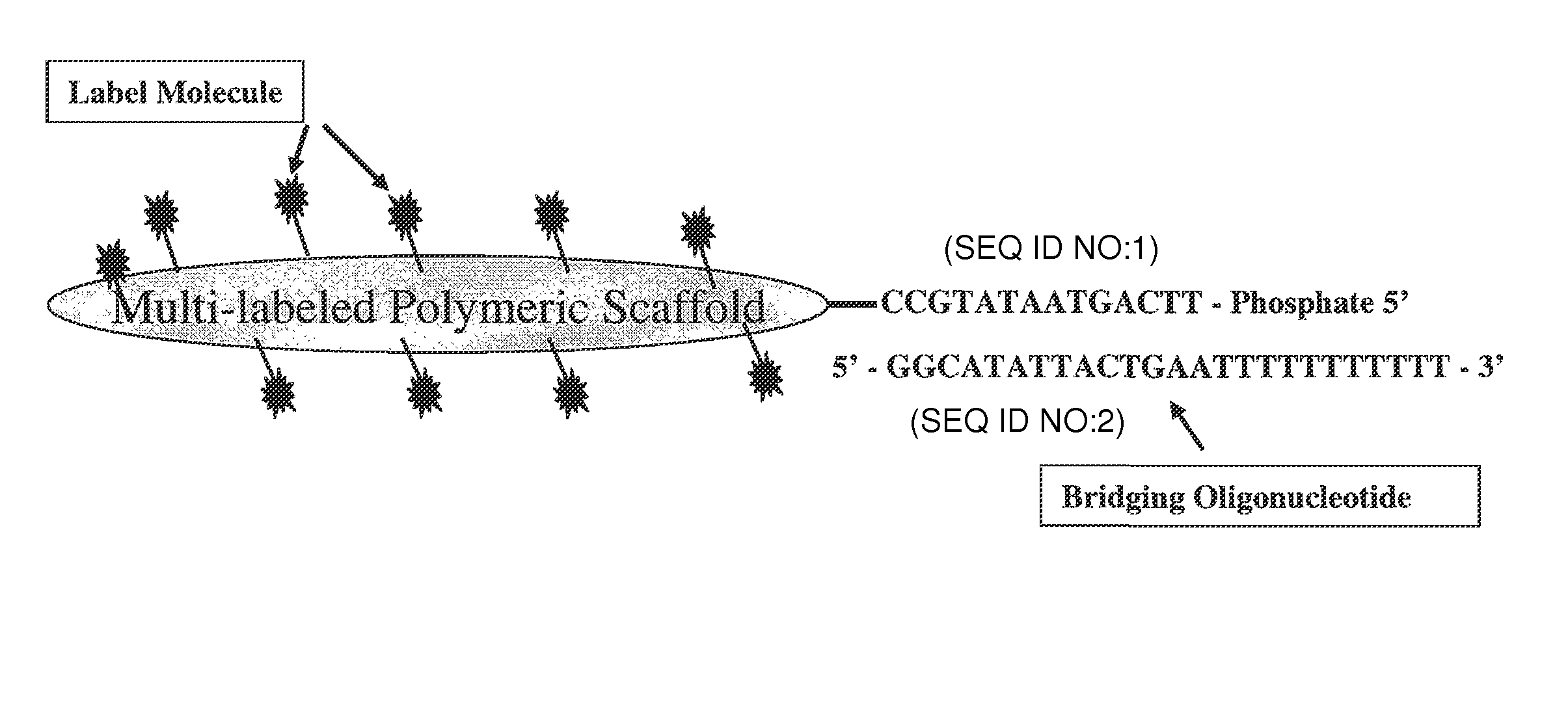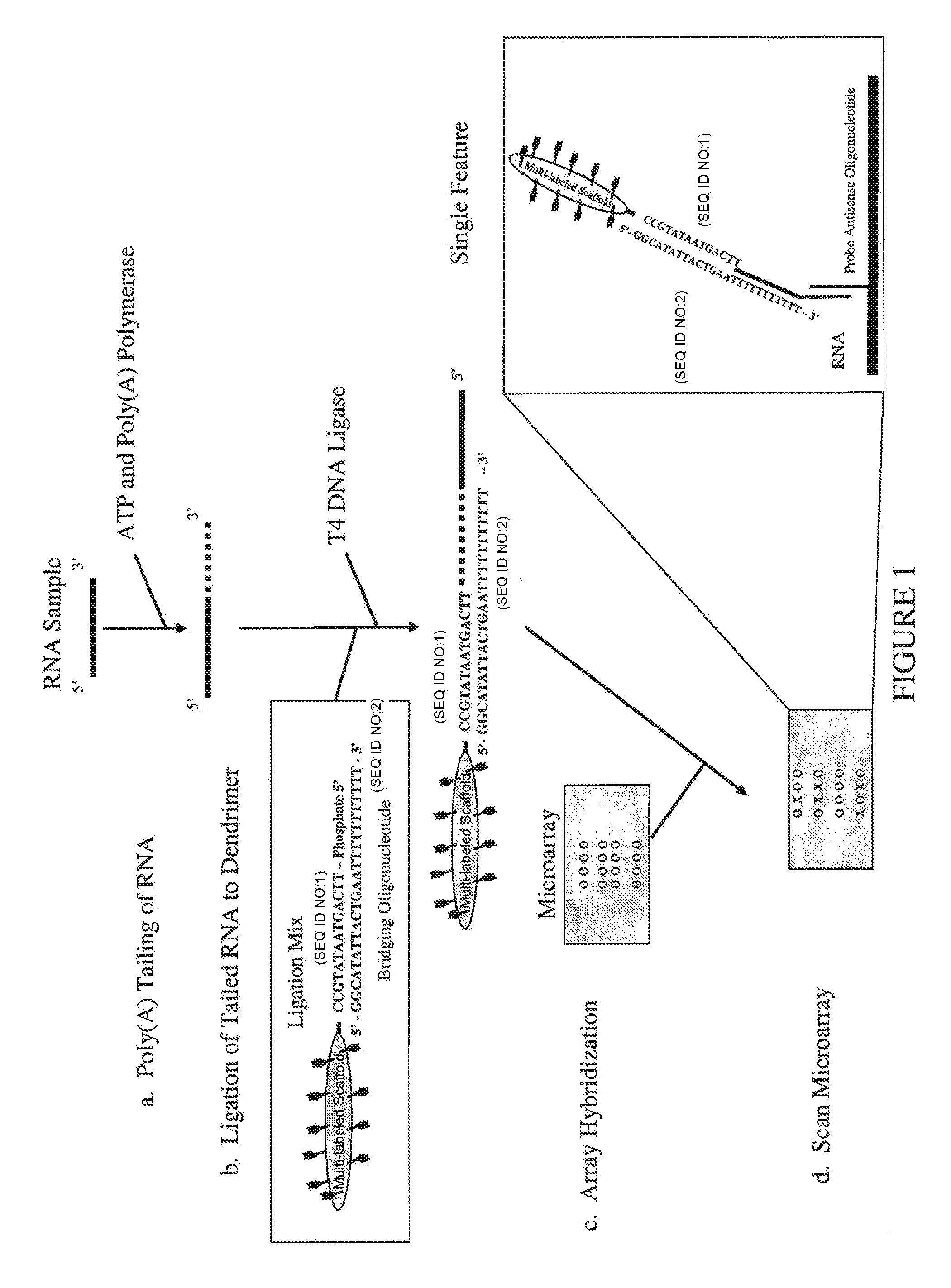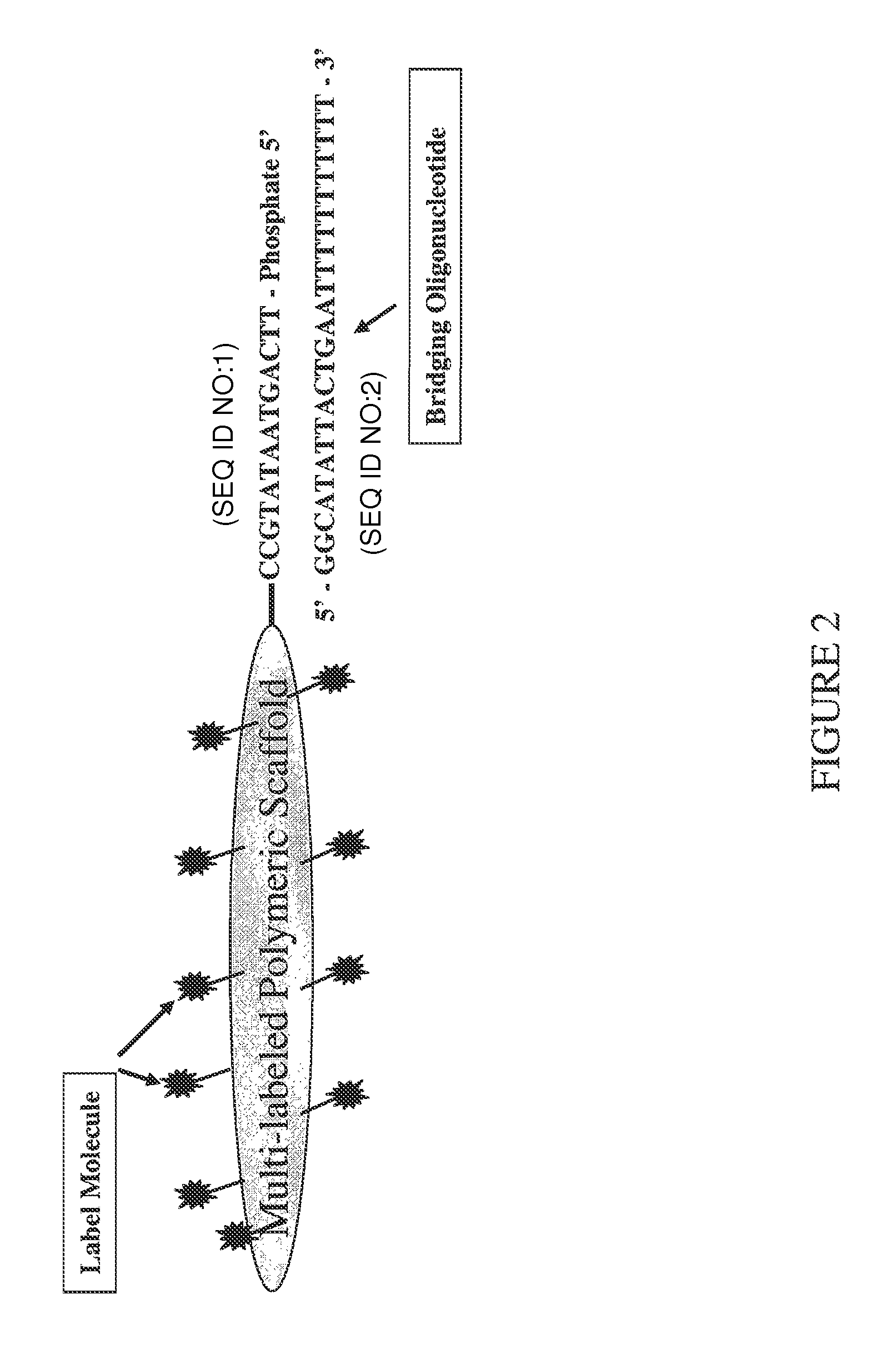Methods, reagents and kits for detection of nucleic acid molecules
a technology kits, applied in the field of methods, reagents and kits for detection of nucleic acid molecules, can solve the problems of pcr introducing significant biases into the population of amplified target, too labor-intensive methods for high-throughput analyses, and insufficient detection accuracy, etc., to achieve enhanced signal intensity, reduced noise, and small size
- Summary
- Abstract
- Description
- Claims
- Application Information
AI Technical Summary
Benefits of technology
Problems solved by technology
Method used
Image
Examples
example 1
Labeling of miRNA Molecules in Total RNA and Hybridization to Antisense miRNA Probes
Preparation of a Linear Dendritic Polynucleotide Nucleic Acid Labeling Molecule
[0062]A trimeric linear dendritic polynucleotide nucleic acid labeling molecule was prepared as described above. The labeling molecule had a molecular weight of 165 kDa, contained 15 fluorophore moieties at intervals of 10-15 nt and was cross-linked following assembly using trioxsalen in the presence of UV-A. The labeling molecule contained the 5′-phosphorylated oligonucleotide tail shown in FIG. 2 (5′-TTC AGT AAT ATG CC-3′; SEQ ID NO:1). The UV-irradiated formulation was purified using Microcon® YM-30 microconcentrators, as per the vendor's (Millipore, Billerica, Mass.) instructions.
Preparation of Ligation Mix Containing the Linear Dendritic Polynucleotide Nucleic Acid Labeling Molecule
[0063]Forty-two μl of the purified labeling molecule (2,380 ng / μl) was combined with 12.3 μl of the bridging oligonucleotide (904 ng / μl) s...
example 2
Labeling of miRNA Molecules in Enriched RNA and Hybridization to Antisense miRNA Probes
[0068]The procedures of Example 1 were followed, except that the rat brain and rat liver total RNA were enriched for low molecular weight RNAs prior to microarray hybridization. One and one-half μg of rat brain and rat liver total RNA were separately diluted to 100 μl with 10 mM Tris, pH 8.0, heated to 80° C. for 3 minutes, and cooled on ice. For each RNA sample, a Microcon® YM-100 microconcentrator (Millipore, Billerica, Mass.) was pre-wet by adding 50 μl 10 mM Tris, pH 8.0 and centrifuging for 3 minutes at 13,000 RPM. The columns were placed into new collection tubes and each 100 μl sample was added and centrifuged for 7 minutes at 13,000 RPM. Each flow-through containing low molecular weight RNA molecules (˜95 μl) were concentrated with a Microcon® YM-3 microconcentrator (Millipore, Billerica, Mass.) by centrifuging for 30 minutes at 13,000 RPM. Five μl of 10 mM Tris-HCl, pH 8.0 was then added ...
example 3
ELOSA
Plate Coating
[0070]A CoStar® (Corning, Lowell, Mass.) microtiter plate was coated by adding 100 μl of 1 μg / mL human miR122 antisense DNA oligonucleotide (5′-CAA ACA CCA TTG TCA CAC TCC A-3′; SEQ ID NO:3) in 1×PBS to each well. The plate was covered with a microplate press-on sealer (PerkinElmer, Waltham, Mass.) and incubated overnight at room temperature. The plate was then washed 2 times with 1×PBS, 0.05% Tween-20, and blotted dry.
Plate Blocking and miRNA Labeling
[0071]Two-hundred μl 4% BSA in 1×PBS was added to each well. The plate was covered and incubated for 1-2 hours at room temperature. During the plate blocking incubation time, miRNA molecules in total and enriched RNA were labeled. Low molecular weight RNA was enriched from 1 μg, 0.75 μg, 0.5 μg, and 0.25 μg of rat liver total RNA (Ambion, Austin, Tex.) using Microcon® YM-100 microconcentrators (Millipore, Billerica, Mass.) followed by concentration with Microcon® YM-3 microconcentrators (Millipore, Billerica, Mass.) a...
PUM
| Property | Measurement | Unit |
|---|---|---|
| molecular weight | aaaaa | aaaaa |
| pH | aaaaa | aaaaa |
| pH | aaaaa | aaaaa |
Abstract
Description
Claims
Application Information
 Login to View More
Login to View More - R&D
- Intellectual Property
- Life Sciences
- Materials
- Tech Scout
- Unparalleled Data Quality
- Higher Quality Content
- 60% Fewer Hallucinations
Browse by: Latest US Patents, China's latest patents, Technical Efficacy Thesaurus, Application Domain, Technology Topic, Popular Technical Reports.
© 2025 PatSnap. All rights reserved.Legal|Privacy policy|Modern Slavery Act Transparency Statement|Sitemap|About US| Contact US: help@patsnap.com



